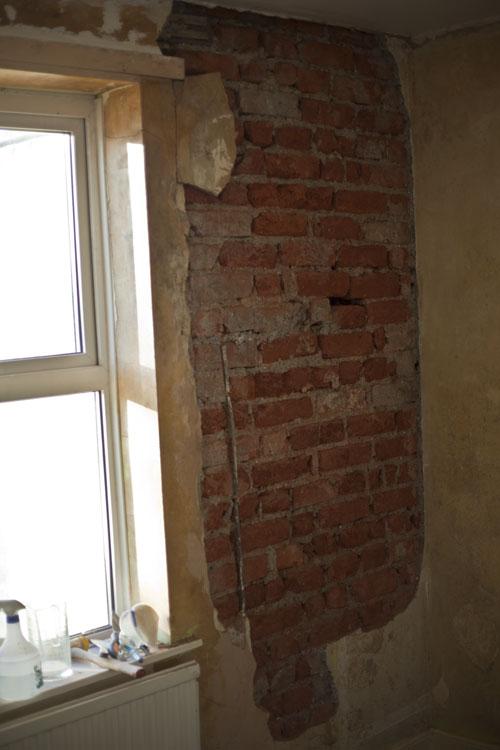Hello all,
I recently moved into a Victorian terrace property which required a little patching up. After purchasing the property we asked a local damp expert to come round and give us some advice. In one of the bedrooms he found some slight damp adjacent to the window in the external wall. This room is intended to be a nursery for our 5 month old boy, so we felt it was important to sort out any damp problems before renovating the room (and indeed after removing all the wallpaper there was fungus/mould on the plaster around the affected area - roughly 2 square meters)
His advice was to strip back the plaster and leave the brickwork to dry, then replaster. At the same time, rectify the source of the damp, which is some cracks in the external cement rendering near to the window.
The stage I am at is that I have removed all of the plaster from the area, except from the render directly around the window. The brickwork is pretty crumbly, but is sound. The masonary doesn't 'feel' damp, but the surface of the bricks is soft and can be scraped off with a fingernail.
I am waiting for a spell of sunny weather (some hope...!!) to patch up the cracks in the external wall, but once this is done how long should I wait to dry out the brickwork?
How do I tell when it is ready for replastering? As I say the bricks don't actually feel damp, so is there something I should look out for or a test I can carry out?
I have also read on this forum that there is no real need to repoint the brickwork if it is going to be replastered. But does this apply to an area affected by damp? I attach a photo of the room, and advice is greatly appreciated on how to proceed with this project.
One last question... there is a piece of what looks like a pipe under the plaster (you can see this in the photo - a vertical line towards the bottom of the brickwork). When I was first removing the plaster I thought this was an electricity cable, but it is metal and quite flexible (lead) but goes nowhere, it just comes out of the lower section of plaster towards the floorboards and stops half way up the wall. Any ideas what this could be?
Regards
Tom
I recently moved into a Victorian terrace property which required a little patching up. After purchasing the property we asked a local damp expert to come round and give us some advice. In one of the bedrooms he found some slight damp adjacent to the window in the external wall. This room is intended to be a nursery for our 5 month old boy, so we felt it was important to sort out any damp problems before renovating the room (and indeed after removing all the wallpaper there was fungus/mould on the plaster around the affected area - roughly 2 square meters)
His advice was to strip back the plaster and leave the brickwork to dry, then replaster. At the same time, rectify the source of the damp, which is some cracks in the external cement rendering near to the window.
The stage I am at is that I have removed all of the plaster from the area, except from the render directly around the window. The brickwork is pretty crumbly, but is sound. The masonary doesn't 'feel' damp, but the surface of the bricks is soft and can be scraped off with a fingernail.
I am waiting for a spell of sunny weather (some hope...!!) to patch up the cracks in the external wall, but once this is done how long should I wait to dry out the brickwork?
How do I tell when it is ready for replastering? As I say the bricks don't actually feel damp, so is there something I should look out for or a test I can carry out?
I have also read on this forum that there is no real need to repoint the brickwork if it is going to be replastered. But does this apply to an area affected by damp? I attach a photo of the room, and advice is greatly appreciated on how to proceed with this project.
One last question... there is a piece of what looks like a pipe under the plaster (you can see this in the photo - a vertical line towards the bottom of the brickwork). When I was first removing the plaster I thought this was an electricity cable, but it is metal and quite flexible (lead) but goes nowhere, it just comes out of the lower section of plaster towards the floorboards and stops half way up the wall. Any ideas what this could be?
Regards
Tom


